aquí la calidad de vida es alta,
buena para el sistema digestivo,
para los huesos buena, y el bolsillo.
Without Peru, modern American civilization might not be here. With the exception of maize and squash, almost every native American food we eat in quantity today hailed from the Inca empire of the 12th to 14th centuries. Potatoes, quinoa, a huge number of chile peppers, tomatoes, peanuts: all hail from the west side of South America.

Peruvian food is at once alien and comforting: a fairly short list of familiar foods combined in unexpected ways. Lawrence Durrell once said that olives had a taste as old as cold water; that same sense pervades Peruvian food. Even modern, high-end Peruvian dishes carry the pedigree of more than a thousand years of tradition; eating Peruvian is a bridge to the past in a way few cuisines can match.
]
That's not to say that Peruvians aren't open to culinary commingling:
Thor Heyerdahl proved that Peru in 1947 was well within range of Asian
explorers, even given the technology of Inca times; there are thousands
of Asians in Peru. There is a huge ethnic Japanese population in Peru
(the former President of Peru was named Alberto Fujimori), and Chinese
cooking is so prevalent that the word for it in Peruvian Spanish is
chifa, from 吃饭 (chi fan), meaning “eat”.
Peruvian cuisine has lots of divisions, but arguably the most useful
division is coastal food vs. mountain (Andean) food. Much of what is
served in Peruvian restaurants in the United States owes at least a
token nod to the cuisine of the Pacific, but some mountain specialities
show up now and then.
Today's episode of Ethnic Eating 101 covers appetizers and first courses in Peruvian food.
Ceviche
Every tostada de ceviche in every Mexican restaurant in the world is
trying to live up to its Peruvian counterpart. There are no tomatoes
in Peruvian ceviche, there is no Clamato juice, there is no cilantro
and no garlic. The list of ingredients in a Peruvian ceviche are
simple: fish or seafood, salt, lime juice, onions and rocoto or limo
chiles. The ingredients are blended together and allowed to sit. The
acid of the lime juice wreaks a chemical reaction in the fish, similar
to cooking; the proteins denature and bind up, and the texture becomes
firmer. The acid has a similar, though less powerful, effect on
seafood, which is often cooked with heat before being marinated.
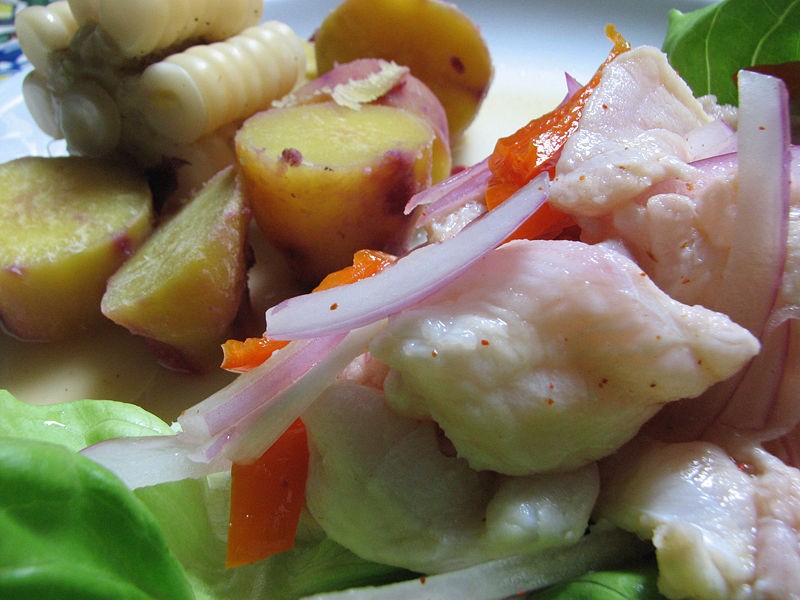
The result is a powerful dish, with fresh fish and a citric punch that
lands in the upper palate. Beer is a good choice to accompany ceviche,
incidentally: the Mexicans got that right, and it will help with the
thirst that ceviche can cause.
True Peruvian ceviche is served very simply, with some or all of these
accompaniments: toasted seaweed, cooked potato, cooked sweet potato,
choclo (enormous, juicy, cooked fresh corn kernels, each about the size
of a man's pinky nail) and cancha (corn kernels that have been parched
in sand, then cleaned and tossed with salt, like the best corn nuts in
the world).
The liquid left over is called leche de tigre–tiger's milk–and is
served as a stimulant and a hangover remedy. A shot of this sour,
spicy, tangy liquid has a caffeine-like effect on the nervous system.
Any Peruvian restaurant in the region will serve a portion leche de tigre
with their ceviche for the asking.[
Causa
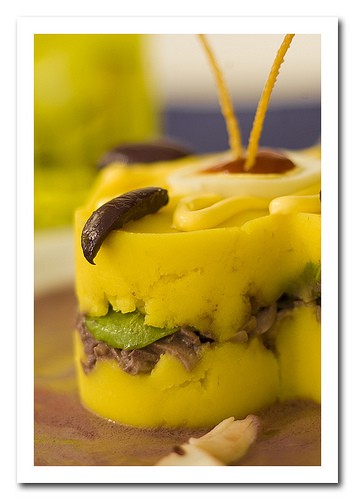
In some ways, potatoes are to Peruvian cuisine what rice is to Chinese
cuisine. Two thousand of the three thousand known varieties of potato
in the world are grown in Peru, from the waxy, yellow, Yukon Gold-like potatoes to
chuños, potatoes which have been dried in the frozen Andean air (this
concentrates the potato flavor).
Causa is technically a potato salad, but what a salad! Traditionally,
causa (pronounced “COW-sah”) is a layered salad, the original ring-mold
idea. Cooked yellow potatoes are mashed with ají (chiles), lime juice,
salt and pepper. A layer of this paste is spread in a container, and
then topped with a filling. The filling may be eggs, shrimp with
avocado, shredded chicken with mayonnaise, crab with vinaigrette,
scallops with orange sauce or any of dozens of other fillings. A second
layer of potato purée is spread on top; more elaborate causa may have a
second layer of filling (the same or different) and a third layer of
potatoes. Causa is served with salsa de ají, the Peruvian chile sauce
made of potent yellow chiles, lettuce, bread and oil; it is addictive.
A different, but extremely common variation is called causa rellena, or sometimes just papa rellena. This is filling enveloped inside the potato purée (often
formed in the shape of a large potato) and usually deep-fried until the
top layer of the potatoes starts to brown, bubble and flake. The most
common filling for causa rellena is a variation on picadillo, chopped
beef cooked with spices, raisins and olives, and nearly all causas
rellenas will have at least a piece of hard-boiled egg tucked inside.
Causa rellena is always served with pickled red onions.
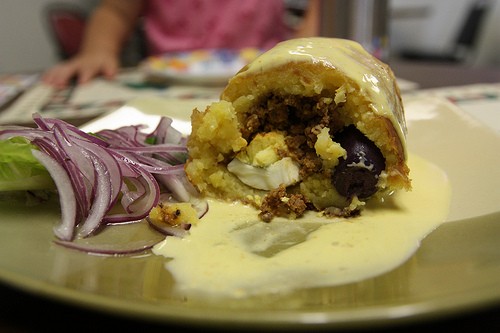
[
Anticuchos
Anticuchos are more technically street food, but they tend to show up
on appetizer lists in this area. Anticuchos are small pieces of meat,
often organ meat such as beef heart, marinated in vinegar, garlic,
cumin and ají panca (a smoked red chile which tastes like spicy Spanish
paprika), threaded onto skewers and grilled over impossibly high heat
until they sear. They are amazingly juicy and, in the case of the
aforementioned beef heart, the beefiest-tasting piece of meat on the
steer after the cheeks.
After grilling, a boiled potato or a thick piece of bread may be
speared on the end of the skewer, both to prevent injury and to provide
a place for the juices to be soaked up.
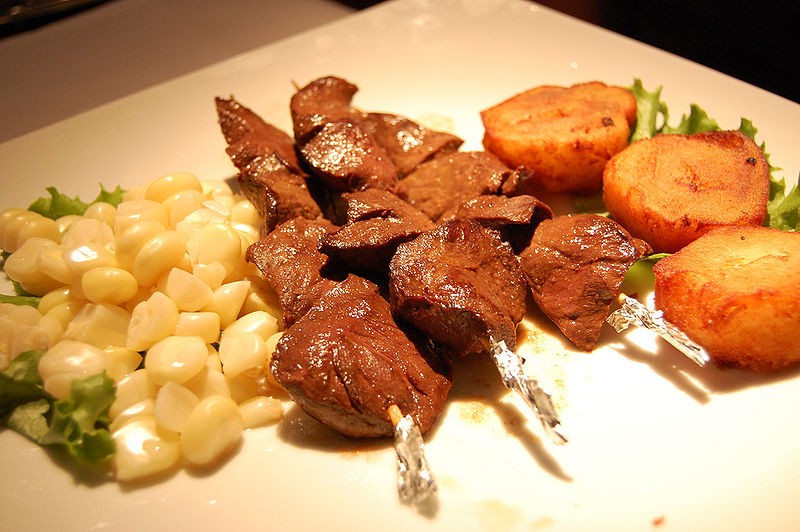
Other anticuchos include higado (beef liver), tripas (book tripe),
rachi (honeycomb tripe), bistec (usually rump steak), pollo (chicken)
or very rarely seafood.
Anticuchos are usually served with choclo (corn on the cob) and
potatoes; the omnipresent chile sauce will be there to add some kick.
Anticuchos make great drinking food, paired with Peru's national drink, the Pisco sour (brandy, lemon juice, sugar and egg whites shaken together) or with dark Cusqueña beer (there are light and dark varieties; the dark is far superior).[
Other Appetizers
Other common appetizers don't fall neatly into categories.
Papa a la huancaina is a cold dish of boiled, sliced waxy potatoes and
hard-boiled eggs covered in ají-cheese sauce with an olive. This is by
far the most common appetizer served in a menú (two or three courses,
prix fixe). Yuca, another tuber, is commonly substituted and has a
sweeter, slightly flour-y taste. A variation called ocopa is boiled,
sliced potatoes, but topped with a sauce of nuts, cheese and huacatay
(black basil).
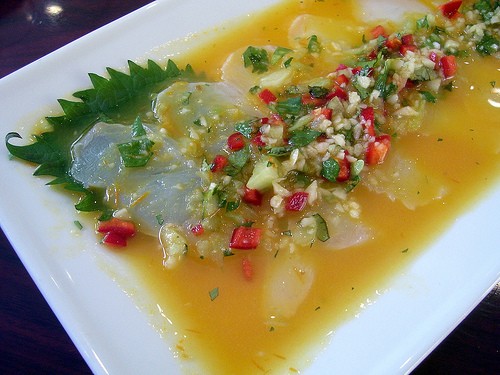
Choros a la chalaca are mussels on the half shell showered with lime juice and corn-tomato-ají salsa.
Tiradito is fresh, raw fish (often firm white fish, but sometimes
tuna), cut like sashimi and marinated briefly in ceviche-style
seasonings. Tiradito nearly always comes with sweet potatoes.
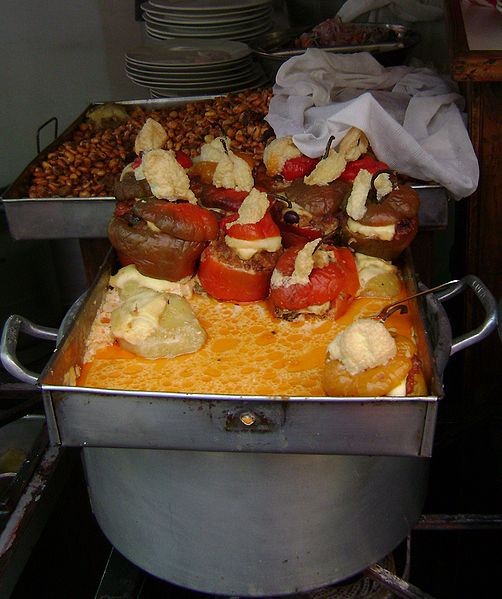
Humitas are the Peruvian answer to tamales, wide packets wrapped in
corn husks and steamed or baked in a pit oven, but using fresh, juicy
choclo in the dough. Humitas normally are stuffed with cheese, not
meat, but humitas dulces are stuffed with raw brown sugar, raisins and
sometimes cinnamon.
Rocotos rellenos are the immensely hot rocoto chile peppers (like
piquins or habaneros) stuffed with meat and onions, then layered with
thinly-sliced potatoes and milk; the milk and the heat temper the
capsaicin enough to make them edible. Once the chile heat passes, the
chiles taste surprisingly sweet.
Incidentally, chicharrón on a Peruvian menu doesn't necessarily have anything to
do with pork skin; it can also refer to something that has been fried.
Chicharrón de camarón is breaded, fried shrimp; chicharrón de calamares
is fried squid.[
Where To Get It
El Misti (3070 W. Lincoln Ave. #D, Anaheim) specializes in
Arequipa-style food; another contender is Inka Grill (23600 Rockfield
Blvd., Lake Forest). Nory's is a pair of restaurants (933 S. Euclid
St., Anaheim; 6959 Cerritos Ave., Stanton) with good ceviche and one of
the better renditions of papa a la huancaina.
If anticuchos are the order of the day, the single best place in all
Southern California to get them, Anticuchería Danessi, lies just over
the Los Angeles county line in Norwalk (14531 S. Pioneer Blvd.).
What's Next
Come back next week for Peruvian-Chinese food! Chaufa and tallarines and saltados and jaleas, oh my.

